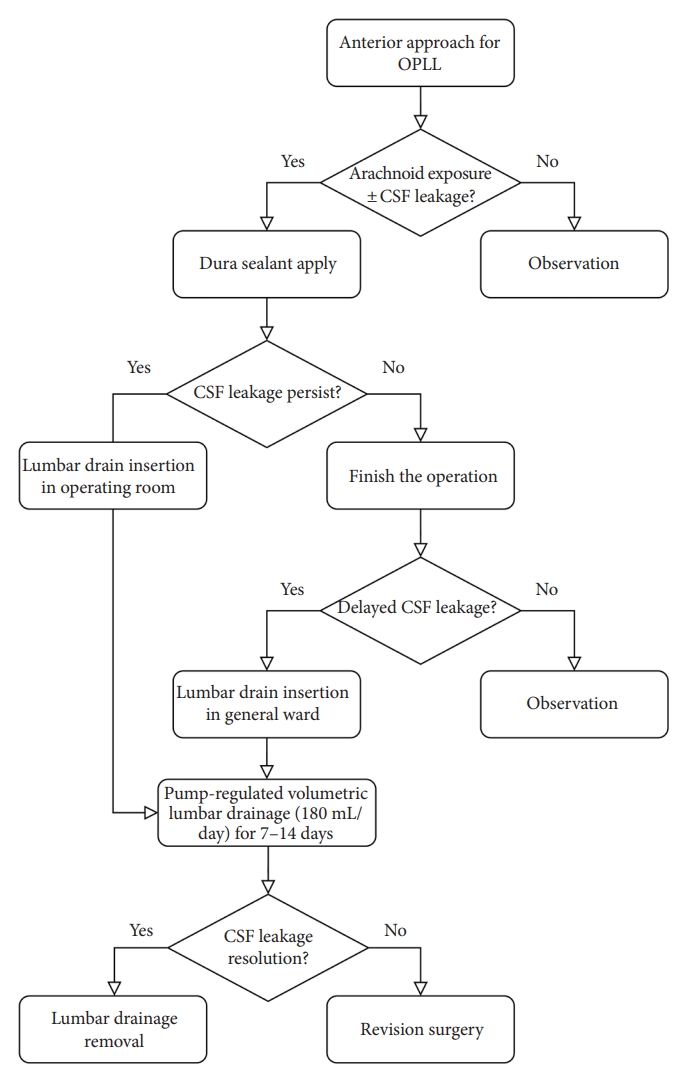2. Saetia K, Cho D, Lee S, et al. Ossification of the posterior longitudinal ligament: a review. Neurosurg Focus 2011;30:E1.

4. Kato Y, Iwasaki M, Fuji T, et al. Long-term follow-up results of laminectomy for cervical myelopathy caused by ossification of the posterior longitudinal ligament. J Neurosurg 1998;89:217-23.


5. Lee CH, Jahng TA, Hyun SJ, et al. Expansive laminoplasty versus laminectomy alone versus laminectomy and fusion for cervical ossification of the posterior longitudinal ligament: is there a difference in the clinical outcome and sagittal alignment? Clin Spine Surg 2016;29:E9-15.

6. Matsumoto M, Chiba K, Toyama Y. Surgical treatment of ossification of the posterior longitudinal ligament and its outcomes: posterior surgery by laminoplasty. Spine (Phila Pa 1976) 2012;37:E303-8.

9. Feng F, Ruan W, Liu Z, et al. Anterior versus posterior approach for the treatment of cervical compressive myelopathy due to ossification of the posterior longitudinal ligament: a systematic review and meta-analysis. Int J Surg 2016;27:26-33.


10. Fujiyoshi T, Yamazaki M, Kawabe J, et al. A new concept for making decisions regarding the surgical approach for cervical ossification of the posterior longitudinal ligament: the K-Line. Spine (Phila Pa 1976) 2008;33:E990-3.

11. Iwasaki M, Okuda Sy, Miyauchi A, et al. Surgical strategy for cervical myelopathy due to ossification of the posterior longitudinal ligament: part 2: advantages of anterior decompression and fusion over laminoplasty. Spine (Phila Pa 1976) 2007;32:654-60.

15. Sun JC, Zhang B, Shi J, et al. Can K-line predict the clinical outcome of anterior controllable antedisplacement and fusion surgery for cervical myelopathy caused by multisegmental ossification of the posterior longitudinal ligament? World Neurosurg 2018;116:e118-27.


16. Stokken J, Recinos PF, Woodard T, et al. The utility of lumbar drains in modern endoscopic skull base surgery. Curr Opin Otolaryngol Head Neck Surg 2015;23:78-82.


17. Governale LS, Fein N, Logsdon J, et al. Techniques and complications of external lumbar drainage for normal pressure hydrocephalus. Neurosurgery 2008;63:379-84. discussion 84.


20. Graf CJ, Gross CE, Beck DW. Complications of spinal drainage in the management of cerebrospinal fluid fistula: report of three cases. J Neurosurg 1981;54:392-5.

21. Houle PJ, Vender JR, Fountas K, et al. Pump-regulated lumbar subarachnoid drainage. Neurosurgery 2000;46:929-32.


22. Swanson SE, Kocan MJ, Chandler WF. Flow-regulated continuous spinal drainage: technical note with case report. Neurosurgery 1981;9:163-5.

23. Mizuno J, Nakagawa H, Matsuo N, et al. Dural ossification associated with cervical ossification of the posterior longitudinal ligament: frequency of dural ossification and comparison of neuroimaging modalities in ability to identify the disease. J Neurosurg Spine 2005;2:425-30.


25. Gazzeri R, Galarza M, Callovini G. Use of tissue sealant patch (TachoSil) in the management of cerebrospinal fluid leaks after anterior cervical spine discectomy and fusion. Br J Neurosurg 2023;37:1406-9.


26. Weill-Engerer S, Meaume S, Lahlou A, et al. Risk factors for deep vein thrombosis in inpatients aged 65 and older: a case-control multicenter study. J Am Geriatr Soc 2004;52:1299-304.


27. Nassr A, Eck JC, Ponnappan RK, et al. The incidence of C5 palsy after multilevel cervical decompression procedures: a review of 750 consecutive cases. Spine (Phila Pa 1976) 2012;37:174-8.

29. Abe H, Tsuru M, Ito T, et al. Anterior decompression for ossification of the posterior longitudinal ligament of the cervical spine. J Neurosurg 1981;55:108-16.


30. Harsh GR, Sypert GW, Weinstein PR, et al. Cervical spine stenosis secondary to ossification of the posterior longitudinal ligament. J Neurosurg 1987;67:349-57.


31. Smith MD, Bolesta MJ, Leventhal M, et al. Postoperative cerebrospinal-fluid fistula associated with erosion of the dura. Findings after anterior resection of ossification of the posterior longitudinal ligament in the cervical spine. J Bone Joint Surg Am 1992;74:270-7.


32. Epstein N. Anterior approaches to cervical spondylosis and ossification of the posterior longitudinal ligament: review of operative technique and assessment of 65 multilevel circumferential procedures. Surg Neurol 2001;55:313-24.


33. Belanger TA, Roh JS, Hanks SE, et al. Ossification of the posterior longitudinal ligament: results of anterior cervical decompression and arthrodesis in sixty-one North American patients. J Bone Joint Surg Am 2005;87:610-5.

34. Choi S, Lee SH, Lee JY, et al. Factors affecting prognosis of patients who underwent corpectomy and fusion for treatment of cervical ossification of the posterior longitudinal ligament: analysis of 47 patients. Clinl Spine Surg 2005;18:309-14.
36. Joseph V, Kumar GSS, Rajshekhar V. Cerebrospinal fluid leak during cervical corpectomy for ossified posterior longitudinal ligament: incidence, management, and outcome. Spine (Phila Pa 1976) 2009;34:491-4.

37. Li H, Dai LY. A systematic review of complications in cervical spine surgery for ossification of the posterior longitudinal ligament. Spine J 2011;11:1049-57.


38. Mazur M, Jost GF, Schmidt MH, et al. Management of cerebrospinal fluid leaks after anterior decompression for ossification of the posterior longitudinal ligament: a review of the literature. Neurosurg Focus 2011;30:E13.

41. Kala M. Cerebrospinal fluid pseudocyst after anterior stabilization for cervical spine injury treated by ventricular drainage: case report. Surg Neurol 1996;45:293-5.


42. Chang HS, Kondo S, Mizuno J, et al. Airway obstruction caused by cerebrospinal fluid leakage after anterior cervical spine surgery: a report of two cases. J Bone Joint Surg Am 2004;86:370-2.

43. Andrew SA, Sidhu KS. Cervical-peritoneal shunt placement for postoperative cervical pseudomeningocele. Clin Spine Surg 2005;18:290-2.
44. Kitchel SH, Eismont FJ, Green BA. Closed subarachnoid drainage for management of cerebrospinal fluid leakage after an operation on the spine. J Bone Joint Surg Am 1989;71:984-7.


45. Hannallah D, Lee J, Khan M, et al. Cerebrospinal fluid leaks following cervical spine surgery. J Bone Joint Surg Am 2008;90:1101-5.


46. Carlson GD, Oliff HS, Gorden C, et al. Cerebral spinal fluid pressure: effects of body position and lumbar subarachnoid drainage in a canine model. Spine (Phila Pa 1976) 2003;28:119-22.


































